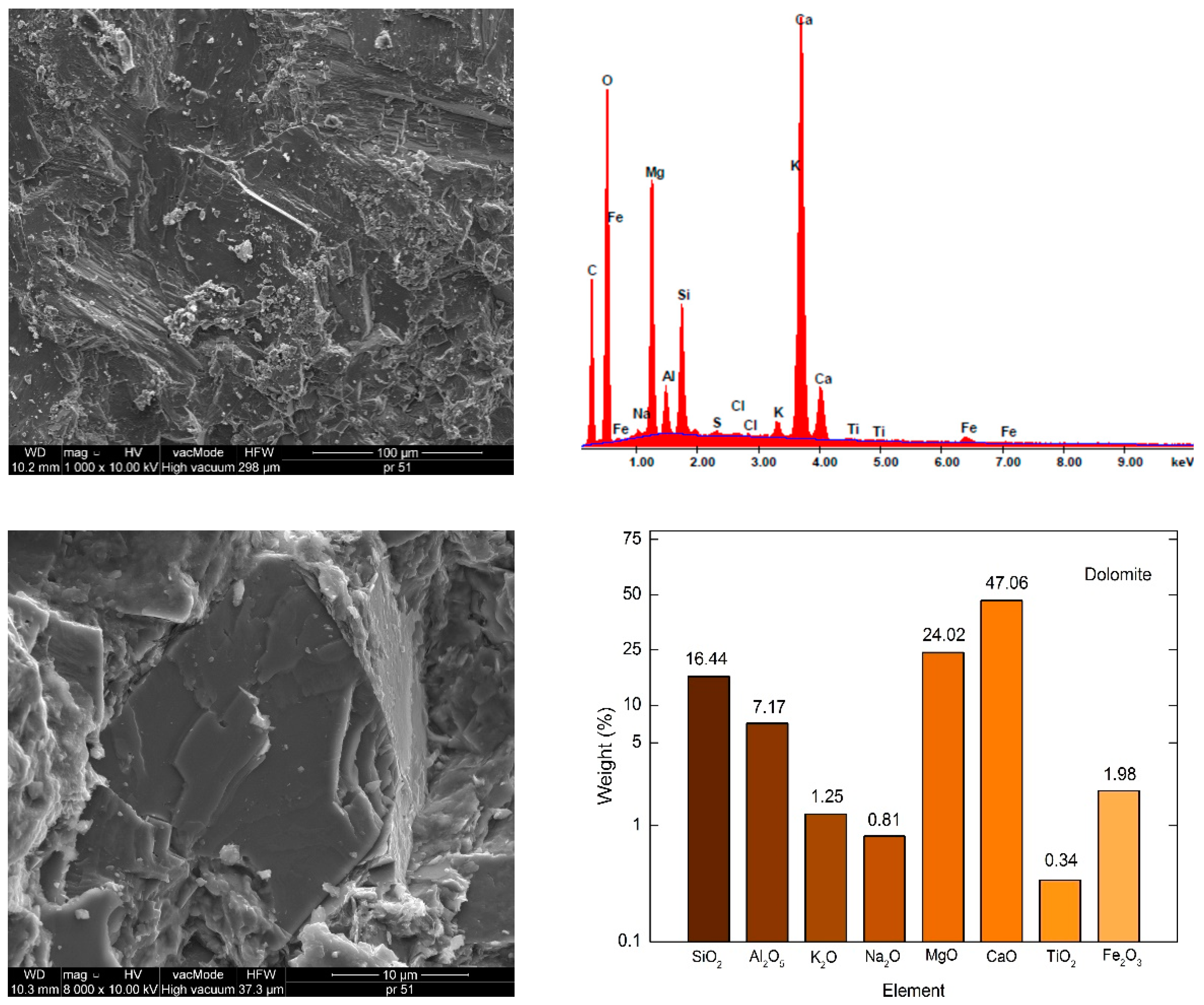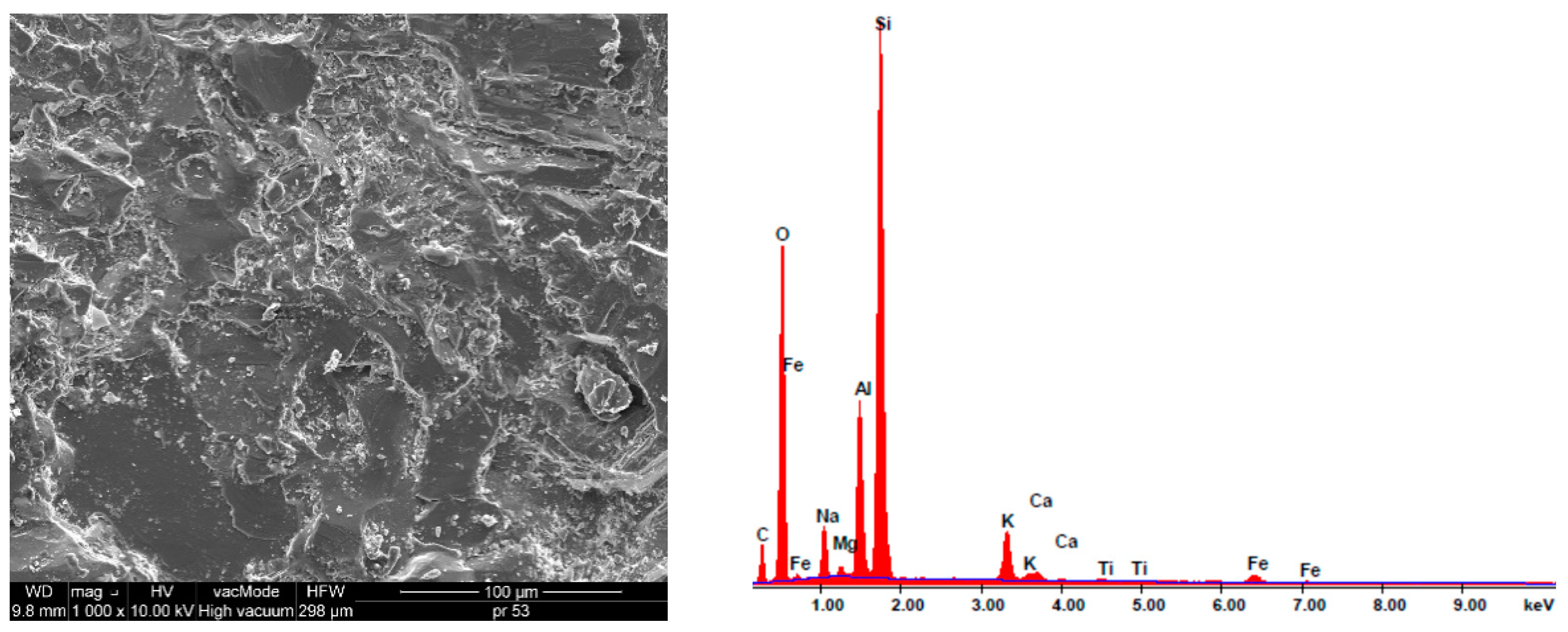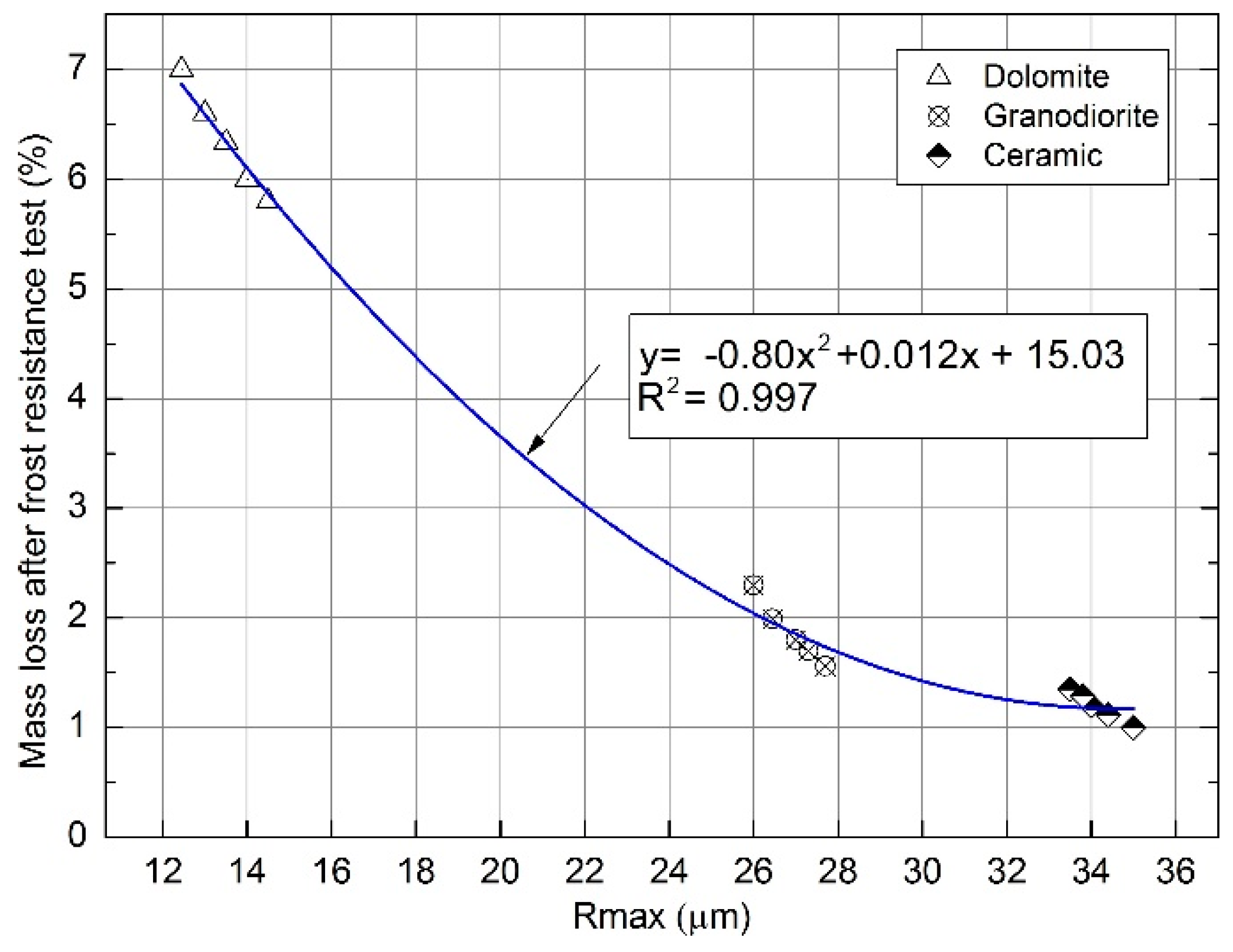Physical Properties of Mineral and Recycled Aggregates Used to Mineral-Asphalt Mixtures
Abstract
1. Introduction
- The chemical nature of the aggregate; depending on the amount of silica contained in the aggregate, we divide them into acid, alkaline and intermediate,
- Physicochemical properties of asphalts—such as viscosity and adhesion, which depends on the content of acidic compounds.
- Acid—with a silica content >65%,
- Alkaline—with a silica content <55%,
- Intermediate—with a silica content in the range 55% to 65%.
2. Materials and Methods
2.1. Material Properties
2.2. Methods
3. Results
3.1. Physical and Mechanical Characteristics of the Tested Aggregates
- 30% to 90% for basalt;
- 60% to 90% for limestone;
- 40% to 80% for granite.
3.2. Microroughness
3.3. Microstructure of Aggregates
4. Discussion
4.1. Physical and Mechanical Characteristics of the Tested Aggregates
4.2. Microroughness
4.3. Microstructure of Aggregates
5. Conclusions
- Crushed waste ceramic aggregate meets the requirements for the shape of the aggregate grains, and at the same time contains a larger but acceptable amount of irregular grains than granodiorite and dolomite aggregate.
- All aggregates have sufficient resistance to cyclic freezing and thawing as well as resistance to grinding. Resistance to grinding is a particularly important feature in the case of aggregates used for wearing layers, where, as a result of car traffic, abrasion and grinding of aggregate grains occurs. It was noticeable that the higher resistance to aggregate grinding also influenced its higher frost resistance, which in turn is of great importance in terms of wear and durability of asphalt surface.
- In the case of tested aggregates and applied binders, the adhesion of asphalt binder to aggregate grains is not sufficient. Adhesives that improve the adhesion of asphalt to the aggregate should be used—which in turn will ensure permanent bonding of its grains. Subsequently, it will lead to the possibility of designing and making asphalt surfaces with high durability and good operational properties.
Author Contributions
Funding
Conflicts of Interest
References
- Stefańczyk, B.; Mieczkowski, P. Mineral-Asphalt Mixtures; WKiŁ: Warsaw, Poland, 2009. [Google Scholar]
- Piłat, J.; Radziszewski, P. Road Surfaces; WKŁ: Warszaw, Poland, 2004. [Google Scholar]
- Diab, A.; Enieb, M. Investigating influence of mineral filler at asphalt mixture andmastic scales. Int. J. Pavement Res. Technol. 2018, 11, 213–224. [Google Scholar] [CrossRef]
- Remisova, E. Study of mineral filler effect on asphalt mixtures properties. In Bituminous Mixtures & Pavements VI; Nikolaides, A., Ed.; Taylor & Francis Group: London, UK, 2015; ISBN 978-1-138-02866-1. [Google Scholar]
- Read, J.; Whiteoak, D.; Hunter, R.N. The Shell Bitumen Handbook; Thomas Telford: Telford, UK, 2003; ISBN 13: 9780727732200. [Google Scholar]
- Iwański, M. Asphalt adsorption by aggregate in mineral-asphalt mixture. Drogownictwo 2012, 9, 290–296. [Google Scholar]
- Sadowski, Ł.; Stefaniuk, D.; Hoła, J. The effect of the porosity within the interfacial zone between layers on pull-off adhesion. Constr. Build. Mater. 2017, 152, 887–897. [Google Scholar] [CrossRef]
- Iwański, M. The use of Carbonate Aggregates in Road Construction; Stow. Przem. Wapienniczego: Cracow, Poland, 2013; ISBN 978-83-925644-2-3. [Google Scholar]
- Błażejewski, K.; Styk, S. Asphalt Layer Technology; WKŁ: Warsaw, Poland, 2004. [Google Scholar]
- Cai, L.; Shi, X.; Xue, J. Laboratory evaluation of composed modified asphalt binder and mixture containing nano-silica/rock asphalt/SBS. Constr. Build. Mater. 2018, 172, 204–211. [Google Scholar] [CrossRef]
- Shi, X.; Cai, L.; Xu, W.; Fan, J.; Wang, X. Effects of nano-silica and rock asphalt on rheological properties of modified bitumen. Constr. Build. Mater. 2018, 161, 705–714. [Google Scholar] [CrossRef]
- Gaweł, I.; Kalabińska, M.; Piłat, J. Asfalty Drogowe; WKŁ: Warsaw, Poland, 2001. [Google Scholar]
- Hou, Y.; Ji, X.; Li, J.; Li, X. Adhesion between asphalt and recycled concrete aggregate and its impact on the properties of asphalt mixture. Materials 2018, 11, 2528. [Google Scholar] [CrossRef]
- Šernas, O.; Vorobjovas, V.; Vaitkus, A. Evaluation of asphalt mix with dolomite aggregates for wearing layer. Transp. Res. Procedia 2016, 14, 732–737. [Google Scholar] [CrossRef]
- Woszuk, A.; Wróbel, M.; Franus, W. Influence of waste engine oil addition on the properties of zeolite-foamed asphalt. Materials 2019, 12, 2265. [Google Scholar] [CrossRef]
- Woszuk, A.; Bandura, L.; Franus, W. 2019, Fly ash as low cost and environmentally friendly filler and its effect on the properties of mix asphalt. J. Clean. Prod. 2019, 235, 93–502. [Google Scholar] [CrossRef]
- Halicka, A.; Ogrodnik, P.; Zegardło, B. Using ceramic sanitary ware waste as concrete aggregate. Constr. Build. Mater. 2013, 48, 295–305. [Google Scholar] [CrossRef]
- Ogrodnik, P.; Szulej, J. The assessment of possibility of using sanitary ceramic waste as concrete aggregate—Determination of the basic material characteristics. Appl. Sci. 2018, 8, 1205. [Google Scholar] [CrossRef]
- Awoyera, P.O.; Ndambuki, J.M.; Akinmusuru, J.O.; Omole, D.O. Characterization of ceramic waste aggregate concrete. HBRC J. 2018, 14, 282–287. [Google Scholar] [CrossRef]
- Juan, A.; Medina, C.; Guerra, M.I.; Morán, J.M.; Aguado, P.J.; Sánchez de Rojas, M.I.; Frías, M.; Rodríguez, O. Re-use of ceramic wastes in construction. Ceramic Mater. 2010. [Google Scholar] [CrossRef]
- Silvestre, R.; Medel, E.; García, A.; Navas, J. Using ceramic wastes from tile industry as a partial substitute of natural aggregates in hot mix asphalt binder courses. Constr. Build. Mater. 2013, 45, 15–122. [Google Scholar] [CrossRef]
- Feng, D.; Yi, J.; Wang, D. Performance and thermal evaluation of incorporating waste ceramic aggregates in wearing layer of asphalt pavement. J. Mater. Civ. Eng. 2013, 25, 857–863. [Google Scholar] [CrossRef]
- Andrzejuk, W.; Barnat-Hunek, D.; Siddique, R.; Zegardło, B.; Łagód, G. Application of recycled ceramic aggregates for the production of mineral-asphalt mixtures. Materials 2018, 11, 658. [Google Scholar] [CrossRef]
- Polish Dolomite Mine Piskrzyń (Piskrzyn, Poland) and Tomashgorodskiy Shchebenevyy Zavod (Rivne, Ukraine). Manufacturer’s Declaration of performance; 2018.
- Polish Committee for Standardization. PN-EN 933-4. Tests for Geometrical Properties of Aggregates. Determination of Particle Shape. Shape Index; PKN: Warsaw, Poland, 2008. [Google Scholar]
- Polish Committee for Standardization. PN-EN 933-3. Tests for Geometrical Properties of Aggregates. Determination of Particle Shape. Flakiness Index; PKN: Warsaw, Poland, 2012. [Google Scholar]
- Polish Committee for Standardization. PN-EN 1097-2. Tests for mechanical and physical properties of aggregates. Methods for Determination of Resistance to Fragmentation; PKN: Warsaw, Poland, 2010. [Google Scholar]
- Polish Committee for Standardization. PN-EN 1367-6. Tests for Thermal and Weathering Properties of Aggregates. Determination of Resistance to Freezing and Thawing in the Presence of Salt (NaCl); PKN: Warsaw, Poland, 2008. [Google Scholar]
- Polish Committee for Standardization. PN-EN 12697-11, A Method. Bituminous Mixtures. Tests Methods for Hot Mix Asphalt. Determination of the Affinity Between Aggregate and Bitumen; PKN: Warsaw, Poland, 2012. [Google Scholar]
- Barnat-Hunek, D.; Widomski, M.; Szafraniec, M.; Łagód, G. Impact of different binders on the roughness, adhesion strength, and other properties of mortars with expanded cork. Materials 2018, 11, 364. [Google Scholar] [CrossRef]
- Barnat-Hunek, D.; Łagód, G.; Fic, S.; Jarosz-Hadam, M. Effect of Polysiloxanes on roughness and durability of basalt fibres reinforced cement mortar. Polymers 2018, 10, 420. [Google Scholar] [CrossRef]
- Santos, P.M.D.; Júlio, E.N.B.S. A state-of-the-art review on roughness quantification methods for concrete surfaces. Constr. Build. Mater. 2013, 38, 912–923. [Google Scholar] [CrossRef]
- WT-1 2014 Aggregates, Technical Requirements; General Directorate for National Roads and Motorways: Warszawa, Poland, 2014. (In Polish)
- Piłat, J.; Radziszewski, P.; Król, J. Technology of Materials and Road Surfaces; Oficyna Wydawnicza Politechniki Warszawskiej: Warsaw, Poland, 2015. [Google Scholar]
- Andrzejuk, W.; Barnat-Hunek, D.; Fic, S.; Styczeń, J. Wettability and surface free energy of mineral-asphalt mixtures with dolomite and recycled aggregate. IOP Conference Series. Mater. Sci. Eng. 2019, 471. [Google Scholar] [CrossRef]
- Hay, K.M.; Dragila, M.I.; Liburdy, J. Theoretical model for the wetting of a rough surface. J. Colloid Interface Sci. 2008, 325, 472–477. [Google Scholar] [CrossRef]
- Naga, S.M.; Bondioli, F.; Wahsh, M.M.S.; El-Omla, M. Utilization of granodiorite in the production of porcelain stoneware tiles. Ceram. Int. 2012, 38, 6267–6272. [Google Scholar] [CrossRef]
- Sybilski, D. Modifiers and additives for road asphalts. Part 1. Modifiers and binders. Drogownictwo 2000, 2, 35–41. [Google Scholar]
- Sybilski, D. Modifiers and additives for road asphalts. Part 2. Modifiers and additives to mixtures. Drogownictwo 2000, 3, 67–71. [Google Scholar]






| Granodiorite | Dolomite | |
|---|---|---|
| Specific density (kg/dm3) | 2.67 | 2.80 |
| Bulk density (kg/dm3) | 2.63 | 2.60 |
| Absorptivity (WA24), % | WA242 | WA242 |
| Abrasion resistance (MDE), % | M2 | MDE10 |
| Polished stone value (PSV) | PSV50 | PSV44 |
| Frost resistance (F), % | F1 | F2 |
| Parameter | Unit | Value |
|---|---|---|
| Penetration at 25 °C | 1/10 mm | 50–70 |
| Softening point | °C | 46–54 |
| Embrittlement temperature | °C | ≤−8 |
| Ignition temperature | °C | ≥230 |
| Solubility | % m/m | ≥99.0 |
| Mass change (absolute value) | % m/m | ≤0.5 |
| Remaining penetration at 25°C | % | ≥50 |
| Softening point increase | °C | ≤9 |
| Parameter | Unit | Value |
|---|---|---|
| Penetration at 25 °C | 1/10 mm | 45–80 |
| Softening point | °C | ≥55 |
| Tensile force (strain energy) | J/cm2 | ≥3 at 5 °C |
| Weight change after aging | % m/m | ≤0.5 |
| Remaining penetration at 25 °C after aging | % | ≥60 |
| Increase in softening temperature after aging | °C | ≤8 |
| Ignition temperature | °C | ≥235 |
| Embrittlement temperature | °C | ≤−15 |
| Elastic recovery at 25 °C | % | ≥70 |
| Storage stability—softening difference | °C | ≤5 |
| Softening temperature decrease after aging | °C | TBR |
| Elastic recovery at 25 °C after aging | % | ≥50 |
| Properties | Granodiorite | Dolomite | Ceramic Aggregate | |
|---|---|---|---|---|
| Shape index SI (%) | 0 | 4 | 20 | |
| Flatness index FI (%) | 1 | 6 | 16 | |
| LA grinding resistance, % | 16 | 23 | 22 | |
| Frost resistance | Freezing–thawing; percentage mass loss | 1.8 | 6.3 | 1.2 |
| FNaCl category | FNaCl5 | FNaCl7 | FNaCl5 | |
| Properties | Granodiorite | Dolomite | Ceramic Aggregate | |||
|---|---|---|---|---|---|---|
| 6 h | 24 h | 6 h | 24 h | 6 h | 24 h | |
| Road asphalt 50/70 | 40 | 30 | 70 | 45 | 60 | 50 |
| 45/80-55 polymer modified asphalt | 40 | 20 | 60 | 40 | 50 | 40 |
| Ra (µm) | Rp (µm) | Rv (µm) | Rmax (µm) | |
|---|---|---|---|---|
| (a) Dolomite | 2.06 | 4.80 | 8.29 | 13.09 |
 | ||||
| (b) Granodiorite | 4.43 | 11.3 | 16.1 | 27.4 |
 | ||||
| (c) Ceramic sanitary | 5.61 | 11.4 | 22.6 | 34.0 |
 | ||||
© 2019 by the authors. Licensee MDPI, Basel, Switzerland. This article is an open access article distributed under the terms and conditions of the Creative Commons Attribution (CC BY) license (http://creativecommons.org/licenses/by/4.0/).
Share and Cite
Andrzejuk, W.; Barnat-Hunek, D.; Góra, J. Physical Properties of Mineral and Recycled Aggregates Used to Mineral-Asphalt Mixtures. Materials 2019, 12, 3437. https://doi.org/10.3390/ma12203437
Andrzejuk W, Barnat-Hunek D, Góra J. Physical Properties of Mineral and Recycled Aggregates Used to Mineral-Asphalt Mixtures. Materials. 2019; 12(20):3437. https://doi.org/10.3390/ma12203437
Chicago/Turabian StyleAndrzejuk, Wojciech, Danuta Barnat-Hunek, and Jacek Góra. 2019. "Physical Properties of Mineral and Recycled Aggregates Used to Mineral-Asphalt Mixtures" Materials 12, no. 20: 3437. https://doi.org/10.3390/ma12203437
APA StyleAndrzejuk, W., Barnat-Hunek, D., & Góra, J. (2019). Physical Properties of Mineral and Recycled Aggregates Used to Mineral-Asphalt Mixtures. Materials, 12(20), 3437. https://doi.org/10.3390/ma12203437






